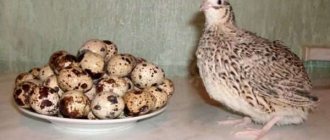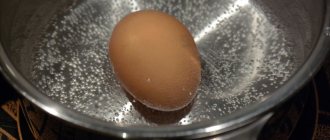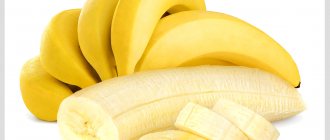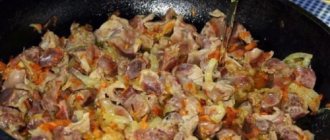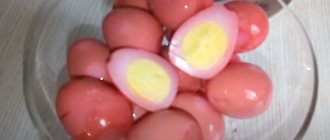874
no comments yet
2
Author:
Ryzhakova Evgenia.
Reading time: 1 minute
I want to talk about freezing chicken eggs for future use, because there are often cases when poultry farmers end up with surplus chicken eggs. And such surpluses cannot be eaten immediately or sold. Freezing is the most optimal method of long-term storage, which will allow you to pamper yourself with eggs from your home chicken even in winter.
Is it possible to eat frozen eggs
Is it possible to eat frozen eggs?
Most people are interested in whether eggs are accidentally frozen, whether they can be eaten. Once they have thawed at room temperature, use them as usual.
REFERENCE: If the shell remains undamaged after freezing, the product can be boiled and consumed boiled or used to make salads. A product with a broken shell should not be boiled, it will simply leak out. It is used to make omelettes and dough.
What to do with eggs after freezing?
Frozen eggs can easily replace fresh ones. Typically, such preparations are used for preparing baked goods, omelettes, salads and other culinary masterpieces. It is important to defrost the composition first. Experienced cooks advise doing this by placing the container in a cool place to avoid sudden temperature changes. Also, do not forget that eggs in any form are very sensitive to bacteria. When the thermometer readings are + 4°C and above, the risk of dangerous infections increases.
Separately frozen yolks are suitable for making creams, scrambled eggs, pancakes, and whites are useful for icing and sponge meringue.
You can make meringue from separately frozen proteins. If a hard-boiled product was frozen, it can be used for casseroles, side dishes and salad dressing.
Many housewives do not welcome this method of storing eggs due to further confusion that arises when it is necessary to measure the required portion of the workpiece. Experienced chefs in such cases advise following the proportion: 1 egg equals 3 tablespoons of egg mixture or 2 tablespoons of separately frozen white and 1 tablespoon of yolk.
How to freeze raw chicken eggs
To freeze properly, you need to follow simple recommendations:
- Do not use products that have expired;
- Freeze without shell;
- To freeze semi-finished eggs in order to later prepare omelettes and baked goods, after grinding the yolks and whites, add 0.5 teaspoon of salt or granulated sugar;
REFERENCE: The choice of ingredient depends on further plans for using the semi-finished product.
- Ice containers can be used as storage containers - three tablespoons per cell is enough. HELP: After freezing, remove the egg cubes and place them in a bag for storage;
- You can freeze the whites and yolks separately.
REFERENCE: Confectionery products, icing, biscuits, meringues, and ice cream are prepared from proteins. Yolks are used for frying croutons or for decorating salads.
ATTENTION: The product can be stored in this form for almost a year.
Freezing technology:
- Carefully crack the eggs into a bowl. HELP: You should not freeze it in the shell, as the contents of the egg will increase in size, push through the shell and spill out;
- Mix them until a homogeneous consistency is formed, trying to avoid getting air into the egg mass. HELP: To obtain a more homogeneous mass, pass through a sieve or colander;
- Pour the egg mixture into a clean container and place it in the freezer. REFERENCE: Exposure to low temperatures causes the product to increase in size, so do not add 1-2 centimeters to the edge of the container;
- Sign the containers. Provide the following information on the label:
- date;
- Quantity.
How freezing affects egg whites and yolks
Eggs are made up of two parts—the yolk and the white—that react differently to freezing.
Texture
Freezing and thawing raw egg whites, which contain mostly water and protein, does not cause a noticeable change in texture after cooking.
However, freezing can improve the foaming ability of egg whites, an important characteristic that is used to make light and fluffy baked goods such as sponge cake ().
One study found that freezing egg whites causes the whites to denature and lose their shape. As a result, egg whites that were frozen and then thawed had better foaming properties ().
In contrast, when raw egg yolks are frozen, they develop a thick, gel-like consistency. This is called congealing, and research shows that it is the result of ice crystals forming in the yolk (,).
However, egg yolks can still be frozen. Adding sugar or salt to them before freezing has been found to improve the texture of thawed and cooked yolks by preventing them from setting ().
Egg yolks also freeze well when combined with egg whites before freezing. The resulting texture is well suited for cooking dishes such as scrambled eggs, baked goods and casseroles.
Taste
While freezing is unlikely to affect the taste of raw or cooked frozen eggs, any ingredients added during various processing methods may.
For example, raw egg yolks may taste slightly sweet or salty depending on whether they were mixed with sugar or salt before freezing.
Additionally, commercially frozen egg products may have added preservatives or other ingredients that may affect the taste. If you are concerned about taste, be sure to read the ingredient list of a frozen egg product before purchasing it.
Freezing boiled eggs
REFERENCE: Boiled whites can be stored, but after the defrosting procedure they do not have a very pleasant taste, compared to yolks, which perfectly retain their taste characteristics.
Freezing technology:
- Boil the eggs hard, remove the shells. Set aside the whites for later use. Place the yolks in a saucepan, add cold water and put on fire.
- After the water boils, close the pan with a lid, turn off the heat and leave the yolks for 10-15 minutes.
- After draining off excess water, remove the yolks from the water with a slotted spoon and place them in a container.
- The yolks are prepared for long-term storage.
Gorloder: boiled recipe, canning
For preservation, you can use the following recipe.
Interesting: Frozen plums with pits
- tomatoes - two and a half kilograms;
- apples - half a kilo;
- sweet pepper - half a kilo;
- garlic – one hundred and twenty grams;
- dill - fifty grams;
- vinegar - two large spoons;
- hot pepper – one hundred grams;
- parsley - fifty grams;
- sunflower oil - one glass;
- black pepper and salt to taste.
- Sterilize and heat the container before storing.
- Wash vegetables under running water.
- Remove seeds and core from peppers and apples.
- Cut the tomatoes into cubes.
- Grind the remaining ingredients in a blender or meat grinder.
Pour the resulting mass into a container, add vinegar, spices and vegetable oil. Place the pan over medium heat and cook for at least 2 hours. Dill and parsley can also be ground in a blender or finely chopped, then added to the sauce before the end of cooking.
The hot seasoning is poured into jars and rolled up.
Jars can be stored in a pantry or basement.
Frozen eggs in shell
In industrial production, to freeze the product in the shell, flash freezing is used at -45°C; this is impossible to do at home. The danger for housewives is bacteria that can get inside through a broken shell. HELP: Before freezing, eggs must be washed in water with the addition of acetic acid, or in a special detergent.
Freezing technology:
- Wash and dry the eggs.
- Place them in a plastic container and first cool them in the refrigerator before storing them in the freezer.
HELP: To avoid shell cracking, quick freezing is necessary.
How to freeze correctly
Few housewives know about methods of freezing eggs, because, without exaggeration, this is the most unexpected product that can be subjected to such storage. And in boiled, raw and shelled form. Let's look into the details.
Hard boiled eggs
Typically, this method involves separately freezing the hard-boiled yolk and white, but most chefs advise storing yolks in this way, since the protein consistency does not change for the better after freezing.
Here are detailed instructions on how to do it correctly:
- Place the eggs in a saucepan, cover with cold water and place on the stove. After boiling, set the heat to slightly above medium and keep the product in boiling water for another 7 minutes.
- Drain the hot water and fill the pan with cold water. This nuance allows the eggs to cook evenly and cool quickly.
- Peel the shell and remove the white.
- Place the yolks in one layer in a saucepan and re-fill with cold water so that it covers them by 2.5 centimeters.
- Cover the pan with a lid and boil the contents. After this, immediately remove the container from the heat, otherwise the yolks will lose their elasticity. Leave them in the water for 10 minutes. After that, strain or remove with a slotted spoon.
- Carefully transfer the product into a plastic container and close the lid tightly. Now the vessel can be placed in the freezer.
A raw egg
This method involves preparing a yolk-white mixture.
It is carried out as follows:
- Carefully break the shell and remove the contents into a clean and dry bowl.
- Mix the composition until a homogeneous mass is obtained, trying to ensure that as little air as possible gets inside.
- Be sure to add a pinch of salt and sugar (can be replaced with honey). Stir again. This is necessary so that after freezing the eggs do not become grainy. To use this preparation as an ingredient for savory dishes, you can limit yourself to salt, calculating half a teaspoon for each glass of the mixture.
- If desired, the mixture should be passed through a sieve to ensure uniform consistency.
- After this, the liquid is poured into a dry container for freezing so that there is about 2 centimeters of space left to the surface, closed tightly and sent to the freezer. If the container is filled to the top, the eggs will expand when freezing and lift the lid, which will not have the best effect on their subsequent texture and taste characteristics.
Whites and yolks separately
If you only need whites or yolks for further culinary processing, you can immediately separate them and freeze them separately.
They do it like this:
- Break the eggs and carefully separate the whites and yolks into separate dry containers.
- Add half a teaspoon of salt to the container with the yolks for each glass of raw mass (for salty dishes) or one and a half tablespoons of sugar (for sweet ones).
- Mix well by hand and pour the contents into a container and cover with an airtight lid. Now the yolks can be sent to the freezer. Just don’t forget to attach a sticker to the container with the date of freezing, the number of yolks used and additives, so as not to confuse the sweet and salty ingredients.
- Now move on to the proteins. They need to be stirred quickly (after standing, they are easier to beat). If the composition contains thread-like particles, pass it through a sieve.
- Pour the protein substance into a freezer container, close the lid tightly and place in the freezer.
In this form, fresh egg whites and yolks can be stored for several months.
Boiled
After heat treatment, only yolks are suitable for freezing. They store well without losing their original properties and texture. Boil eggs the traditional way.
Further actions are simple:
- Separate the whites from the yolk core. They must be used quickly because they lose their structure during the freezing process.
- Place the peeled yolks in a saucepan and cover with cold salted water. Cover with a lid and bring to a boil.
- After 5-10 minutes, remove the product from the cooled water and grind it in a way convenient for you.
- Place the yolk in ice-freezing molds, and when frozen, pour into a plastic zipper bag or container. In this form it will be convenient for you to use the workpiece.
